

Blood of the Irish: What DNA Tells Us About the Ancestry of People in Ireland. Lugh, The Celtic God. Lugh it's the most popular God in Irish Mythology, he was mostly represented as a hero and a High King.
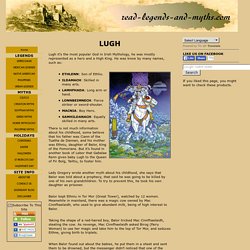
He was know by many names, such as: ETHLENN: Son of Ethliu.ILDAMACH: Skilled in many arts.LAMHFHADA: Long arm or hand.LONNBEIMNECH: Fierce striker or sword-shouter.MACNIA: Boy Hero.SAMHILDANACH: Equally skilled in many arts. There is not much information about his childhood, some believe that his father was Ciann of the Tuatha de Dannan, and his mother was Ethniu, daughter of Balor, King of the Fomorians. But it's found in another book of Lebor that Gabalae Renn gives baby Lugh to the Queen of Fir Bolg, Tailtiu, to foster him.
Lady Gregory wrote another myth about his childhood, she says that Balor was told about a prophecy, that said he was going to be killed by one of his own grandchildren. Balor kept Ethniu in Tor Mor (Great Tower), watched by 12 women. Lesson 1-1 - Fae Folk: The World of the Fae. The Tuatha De Danann: Were they Irish gods or aliens? (PHOTOS) When I came to live in Ireland, it did not take long for me to fall in love with its misty landscape and scattered ancient ruins.
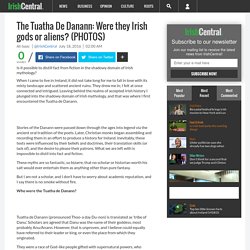
They drew me in; I felt at once connected and intrigued. Leaving behind the realms of accepted Irish history I plunged into the shadowy domain of Irish mythology, and that was where I first encountered the Tuatha de Danann. Stories of the Danann were passed down through the ages into legend via the ancient oral tradition of the poets.
Later, Christian monks began assembling and recording them in an effort to produce a history for Ireland. Inevitably, these texts were influenced by their beliefs and doctrines, their translation skills (or lack of), and the desire to please their patrons. These myths are so fantastic, so bizarre, that no scholar or historian worth his salt would ever entertain them as anything other than pure fantasy. But I am not a scholar, and I don’t have to worry about academic reputation, and I say there is no smoke without fire. Lebor Gabala Erenn. Book of Invasions – mythical history. Book of Invasions – mythical history of Ireland The Book of Invasions is a history of Ireland drawn up in the 11th century and based on oral traditions together with some poems and narrative prose available at the time.
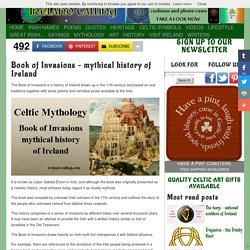
It is known as Lebor Gabála Érenn in Irish, and although the book was originally presented as a realistic history, most scholars today regard it as mostly mythical. The book was compiled by unknown Irish scholars in the 11th century and outlines the story of the people who colonised Ireland from biblical times onwards. This history comprises of a series of invasions by different tribes over several thousand years, It may have been an attempt to provide the Irish with a written history similar to that of Israelites in the Old Testament. The Book of Invasions draws heavily on Irish myth but intersperses it with biblical allusions. The Book of Invasions – Part 1: Cesaire. Writing Irish History – The Four Masters and Their World. Top 10 Irish Myths and Legends — TopTenzNet. The Tale of the Giant's Causeway in Irish Myths and Legends. Miles Johnston - The Secrets of Ireland Land Of The Pharaohs. The Bewitching Tale of Morgan le Fay, a Captivating Character of Arthurian Legend.
The legendary Morgan le Fay is quite often mixed with the Celtic goddess Morrigan.
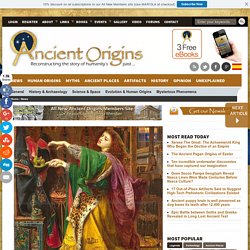
The two strong females seem to be separate women, but there is also a possibility that they are linked with each other. Morgan le Fay is also known as Morgana, Morgane, Morgan le Faye, etc. She is said to be a powerful enchantress, and is also a character of the Arthurian legend. 014 Capricorn Radio - Maurice Cotterell - Holy Grail & Celtic Chronicles. The Body in the Bog: The Murder of Ancient Irish Kings. Startling New Evidence Suggests Stonehenge was First Built in Wales then Transported and Reconstructed 500 Years Later in England. Archaeologists have found the exact holes in a rocky outcrop in Wales from where the bluestones found at Stonehenge originated, revealing that they were quarried 500 years before they were assembled into the famous stone circle that still stands today in Wiltshire, England.
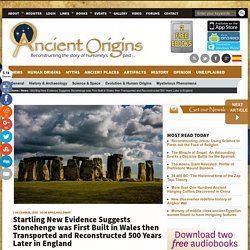
The dramatic discovery suggests that the ancient monument was first erected in Wales and later dismantled, transported, and reassembled over 140 miles away in Salisbury Plain. The Guardian reports that the finding was made during a project run by the University College London (UCL), in cooperation with the universities of Manchester, Bournemouth and Southampton, among others, to investigate quarries in the Preseli Hills in Pembrokeshire, Wales. It has long been known that the bluestones – a term used in a loose sense to cover all of the ‘foreign’ stones which are not native to Salisbury Plain – originated in southwest Wales. Bluestones at Carn Menyn in Wales (public domain) Red Ice Radio - James Swagger - The Irish & Scottish Origins of Halloween. Leprechaun Legends, how to capture him and songs and poems. The Leprechaun legends says that he is a fairy on the Irish folklore, which also its linked in the USA to the St.

Patrick's Day festivities. The first apparition of a Leprechaun, was on the medieval tale of "Adventures of Fergus, Son of Leti", in one chapter Fergus falls asleep in the sand of the beach, and when he wakes up, finds himself being dragged into the ocean by three Luchorpians. He captures the creatures, and they offer Fergus three wishes if he let them go. On the Leprechaun legends, they are usually described as solitary creatures, which their main occupation its to fix or make shoes, putting away all of the coins they receive from this job in a pot of gold hidden in some place that just they know. Leprechauns are really short, no bigger than 24 inches, love to make jokes, mostly practicals. Another characteristic it's that they are good finding the end of the rainbow (a very tricky thing to do), finding a crack of gold in there. Return From Leprechaun Legends To Home Page. World of Mythology.
ANCIENT BRITAIN: Life in Britain & Ireland Before the Romans (Part 1) IRISH ORIGINS OF CIVILIZATION - APPENDIX ONE - The Irish Origins of Civilization. Michael Tsarion - The Irish Origins of Civilization. The O'Cuilleain (O'Collins) and the Hyksos. Atlantis, the Antediluvian World: Part V: Chapter VII: The Irish Colonies From Atlantis. Sacred Texts Atlantis Index Previous Next Buy this Book at Amazon.com Atlantis, the Antediluvian World, by Ignatius Donnelly, [1882], at sacred-texts.com p. 408 WE have seen that beyond question Spain and France owed a great part of their population to Atlantis.

Let us turn now to Ireland. Atlantis, Egypt, and Ireland? By Heather Elizabeth Adams | book-of-thoth.com.
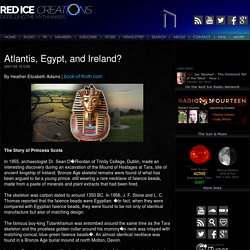
An Illustrated History of Ireland from AD 400 to 1800, Mary Frances Cusack. From AD 400 to 1800 Mary Frances Cusack 'The Nun of Kenmare' Illustrations by Henry Doyle First published in 1868.
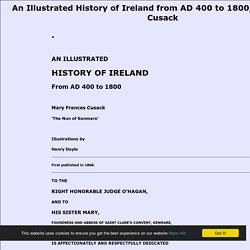
By. TBU_Gog_Magog. According to a history shrouded in myth, this ancient culture is believed to have been of the tribe of Dan who immigrated from the Levant, on the eastern Mediteranean shore, to the Isle of Albion (Britain), bringing with them the harp and the sacred Laig-fial (the Fatal Stone or Stone of Destiny) reputedly used as a pillow by Jacob as he received a prophetic vision, and later used as a support for the Ark of the Covenant in the temple in Jerusalem.
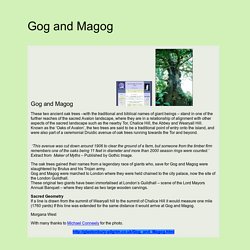
Mbcm. Celtic Mythology by Michel Boucher Mythology A Generic Term Mythology, in its definition, is the speech of stories that refer to specific rituals or feasts. The ritualistic repetition of stories is reserved for a class of individuals generally called priests or shaman. In Rome under the republic, the Pontifex Maximus was, by virtue of this knowledge, the most powerful of men.
He was the spiritual king of Rome. In Celtic studies one cannot truly speak of a mythology in terms of the continental religion. Tuatha Dé Danann. Goddess of war and fertility. Her name, Morrígan (Morrigan), means the "Queen of Demons" or the "Phantom Queen". Morrígan was the daughter of Delbáeth and Ernmas. Morrígan was the sister of Badb, Macha, and possibly of Nemain. CELTIC GODS AND GODDESSES. Abellio Celtic (Gaulish) God of the apple tree. Aine of Knockaine Celtic (Irish) Goddess of love and fertility, later known as the fairy queen. Goddess related to the moon, crops, and farms or cattle. Aine is revered among Irish herbalists and healers and is said to be responsible for the body's life force. Celtic Mythology - the gods of Ireland, Wales, Scotland and Gaul. Introduction The Celts: an amazing conglomeration of tribes with remarkable staying power. Refusing to acknowledge Roman rule, the Celts were formidable fighters under any circumstances.
Exceedingly good at hit-and-run warfare, they were adept at scattering to isolated areas in small groups — taking their Gods with them. Crossing the Veil: The Pre-Christian Origins of Halloween and Samhain. Michael Tsarion - The Druids. The Lost Gods: The Celts. Scottish Myths & Legends. What Lies Beneath Stonehenge? A groundbreaking survey of the site has turned up tantalizing new clues to what really went on there. TOTDLRings - The Pict Sidhe. Celtic mythology. Overview[edit] Though the Celtic world at its apex covered much of western and central Europe, it was not politically unified nor was there any substantial central source of cultural influence or homogeneity; as a result, there was a great deal of variation in local practices of Celtic religion (although certain motifs, for example the god Lugh, appear to have diffused throughout the Celtic world). Inscriptions of more than three hundred deities, often equated with their Roman counterparts, have survived, but of these most appear to have been genii locorum, local or tribal gods, and few were widely worshipped.
Irish mythology. Bunworth Banshee.